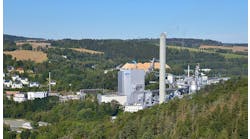Volatile energy costs are on the radar screens of most companies, but at Arkema’s chemical plant in Calvert City, Ky., Dwight Stoffel and his staff were intent upon fixing the inefficiencies of their boiler operations. “From 1989 to 2003, the average price of a barrel of oil was about $20,” explained Robert Horton, business manager, ABB Optimization Services, who presented the results of his group’s consultative efforts with Arkema at ABB Automation and Power World 2009 in Orlando, Fla. “Oil prices are a leader for all energy prices. By 2005, oil was at $50, and when it peaked at around $147 in July 2008, our project was already well underway.”
The Arkema site has four boilers, which produce steam at slightly different levels because they are different sizes and were installed at different times. The first two, both installed in 1952, are brick-set with forced-draft intake and induced-draft removal fans. Both are rated at 40,000 lb steam/hour (klb/hr). The third boiler, a 1965 economizer, includes only a forced-draft fan and is rated at 75 klb/hr, but it was typically operated at a maximum of 60 klb/hr. An additional 1996 economizer FGR boiler was operated identically to the third.
“A reduction in oxygen means real fuel savings.” Robert Horton of ABB Optimization Services explained how chemical manufacturer Arkema made his team’s services pay off in less than six months.
“All four boilers produce steam at about 165 psi,” explained Horton. “But they usually don’t run all four boilers at maximum load. Boiler 2 is the one used most often, but it was the least efficient, so that’s where we began our focus.”
ABB completed a “Fingerprint” analysis of the boiler operations in mid-March 2008, analyzed the collected data and, based on its findings, forecasted annual energy savings of up to $100,000 from improved combustion efficiency, smoother load responses and reduced induced-fan load. The Fingerprint is a four-quadrant approach that examines the state of hardware and controls, the stability and operation of the boiler, combustion load tests and dynamic tests for step responses.
Boiler 2, the most used and most problematic, was examined first, and Horton’s team identified several issues for resolution. The induced-draft fan positioner movement was jerky, indicating a potentially faulty pneumatic cylinder/piston assembly. “The positioner drives were not operating smoothly,” explained Horton. “When we took the boiler down, you could feel it jerk.”
The team also noticed a loose hatch door near the oxygen sensor leaking air into the ductwork before the induced-draft fan. The two boiler oxygen sensors also continued to read about 2% higher than a portable analyzer. “They had two oxygen analyzers that were positioned in the wrong places, and there was leakage,” said Horton. “Plus, the analyzers were out of calibration.”
Air also was being added for an oil flow that wasn’t truly going into the boiler. “We could see oxygen going up and down,” explained Horton. “Air flow and fuel flow measurements were going up and down. They were both exhibiting hysteresis. They were fighting each other and creating variability.”
A furnace draft test also indicated leakage was being sucked in by the induced-draft fan and thrown out the stack as wasted power. “Based on the load tests, we were able to update the air/fuel ratio,” said Horton. “We realized the boilers didn’t need quite as much air. The oxygen trim is that final adjustment of air/fuel ratio, and the Arkema team hadn’t used it for 10 years. It was flat, but we did a bump test to show what it does dynamically.”
Horton’s team recommended a variety of corrections affecting boiler furnace pressure, oxygen settings and transmitters, fan positioner mechanisms, leakage, steam flow measurements, control logic and loop tuning.
As a result, oxygen readings, which had measured in the 6% to 7% range, were brought down to under 5%. “They’re getting really nice control now,” said Horton. “A reduction in oxygen means you’re not bringing in more air than you need, so you don’t have to heat it up, and you don’t have to suck it in and blow it out, so it means real fuel savings.” The approximate value in savings was $75,000 for Boiler 2 alone, and all without major capital investment, said Horton.
In addition to other efficiency improvements across all four boilers, the third boiler, which was underutilized, would trip inexplicably during storms. ABB’s team identified an exposed forced-draft fan with roof intake as the problem. “The positioning of the forced-draft fan on the roof made it totally exposed,” explained Horton. “It was creating a measurement error because wind shear was affecting the measurements from the pitot tubes coming off the fan intake. Arkema built a protective cover to guard against wind shear, and it worked without interruption.” Horton said his team also was able to extend the boiler load. “We showed them it was safe to operate at higher rates,” he explained.
Total annual plant energy savings is about $237,000, said Horton. “The service cost them about $25,000/boiler, so the saving was instant,” he explained.




